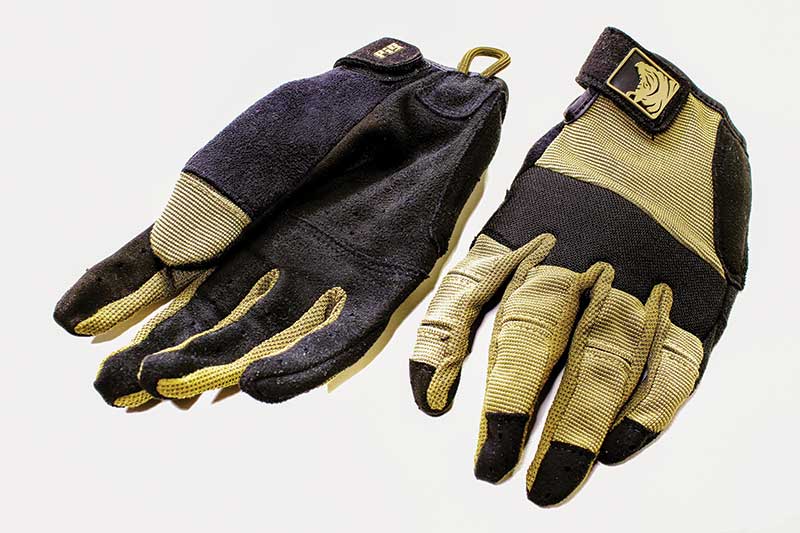My pilots & crews -of course- trained with their nomex flight gloves, so I’m familiar with them. We we also issued several styles of mechanix gloves, and they’re good too.
GLOVE UP!
PROTECT YOUR HANDS FOR BETTER SHOOTING
I’ve finally come around — I believe in gloves for shooters. Not only do they save wear and tear on my hands, but they’ve provided a few more unanticipated benefits. If you aren’t yet a believer, I’m going to convince you.
What WON’T Work
First, not every glove is an adequate shooting glove. Most work gloves are often far too floppy, stiff or bulky to permit dexterity. Loading magazines, for example? Forget about it. Past there, the fingers may be chunky enough to snag in trigger guards and often the leather or cloth is too thick to transmit any appreciable tactile feedback. The same applies to a lot of leather gloves designed for winter weather. Plus, do you really want your nice, soft pair of gloves scratched to hell, covered in oil and caked in unburnt powder? If they were a gift from your wife, she’ll surely — and deservedly — throttle you.
Work gloves are not only unwieldy, but can snag on various
parts of the gun during manipulations. Avoid!
Less Pain
Now you know what to look for, let’s cover why you’d want to use one. First, it reduces cuts and scrapes. Though I wish it were otherwise, most of my guns have hard corners and sharp edges. A good glove can intercept a slide rail cutting a user with a “high thumb” grip, can block hammer bite from a Hi-Power and can keep your palms from being abraded by aggressive grip checkering.
Additionally, you’ll quickly notice the benefits if you’re trying to do any kinds of weapon manipulations aggressively and at speed such as malfunction drills, rapid magazine changes and the like. Trying to “go fast” will very quickly illuminate where the edges of a gun want to bite and it’s nice to have some barrier between flesh and metal when the knowledge comes to light.
Of course, if you’re doing really rough and tumble stuff, you can increase the level of protection. Many brands of gloves include hardened knuckle guards and/or more durable materials and stitching. This will likely take something away from “feel,” but if you’re going to spend a day diving onto gravel to work from the prone position, the tradeoff may be worth it.
A tight fit means ease of precision operations.
More Gain
Gloves can also help you shoot more accurately, as they’re excellent at reducing the worst effects of recoil. To wit, most lightweight .44 Magnums are not fun to shoot by any means. If wooden grips aren’t fitted perfectly to the frame of a magnum revolver, it’s not uncommon for them to draw blood at the web of the hand. When your trigger is a literal “pain lever,” extra padding in the exact area allows hard-kicking guns to shoot to their potential.
The effect isn’t just limited to magnums. There is a very, very well-known brand of polymer handgun that simply doesn’t work for me bare-handed as its medium frame size seems to vector recoil right into the lower bones of my thumb. I can deal with this for one magazine at a time, but when I shoot with a glove, the grip becomes far more “rounded out” and agreeable to my physiology. As a result, I can concentrate on shot placement over managing discomfort.
I also find gloves are a great asset for new shooters who might be recoil-averse. Sure, most of us know to pack a .22 or to bring along some soft-loaded .38 wadcutters to make someone’s first shooting session enjoyable. But suppose you’re specifically helping someone train with a small-framed, polymer gun in .40 S&W?
Gloves are a great way to have them avoid wincing with every pull of the trigger, which means better shot placement. And, as your mentees see tangible improvement on paper, they also build more confidence in their skills and their firearm. They also have more fun — in my estimation, the most critical quality when it comes to creating the next generation of avid shooters.
PIG’s “Alpha” gloves are Clayton’s favorite when it comes to approximating
bare-handed control without sacrificing grip and protection.
Where To Start
Great options exist from Magpul, 5.11 and Oakley, however, I’m partial to gloves from Mechanix and PIG. I look for what Mechanix marks as “high dexterity,” such as the FastFit Tactical Work Gloves. The gloves are reinforced where they need to be and are comfortable, while still allowing manipulations that require precision. I found them particularly nice when shooting magnum handguns as there’s extra leather in the web of the hand.
Patrol Incident Gear’s (PIG) gloves fit tightly and as a result, there’s almost no loss of bare-handed control. Build quality is exceptional for the price. Along with the “Delta” and “Alpha” glove models, they also have the “Echo” specifically designed for women. This is a great kit to help a wife or daughter become truly comfortable with shooting!
As the saying goes, “You’ll never know until you try.” A good pair of gloves will run you less than 50 bucks and pays dividends well in excess of the cost of acquisition. I’ve shot for a long time, but I’m a pragmatist through and through. So long as there are guns I plainly shoot better with gloves, or so long as I own guns I intend to run hard, you’ll never find my range bag without a pair.




